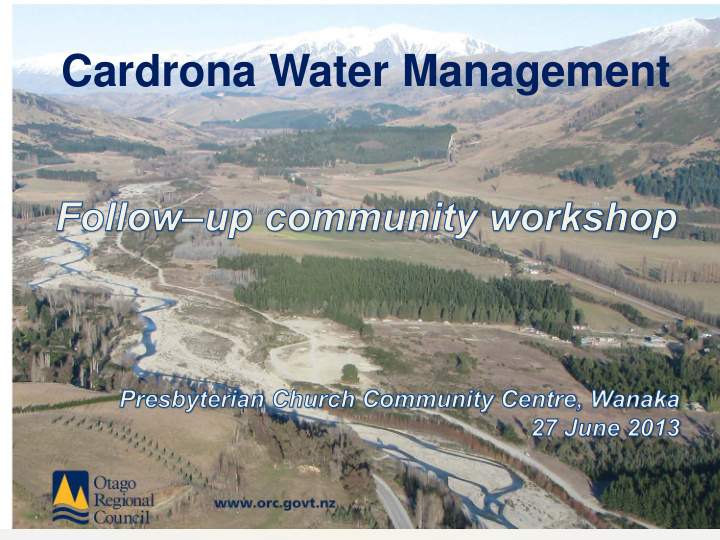



Cardrona Water Management
Today • Introduction • Overview of surface water management options • Social and economic impacts • Feedback session1: Minimum flow and allocation • Overview of groundwater management options • Feedback session 2: Maximum allocation volume • Summary of key messages • Where to from here...
Option A - “Year round flow continuity” 700 l/s @ Clutha confluence • Approx.1,000 l/s at The Larches • Optimum flow for adult and juvenile rainbow trout, and year round habitat for juvenile trout in the lower reaches of the Cardrona • Run of the river irrigation difficult in average or dry year
Option B - “Peak holiday season flow” May – Jan: 700 l/s @ Clutha confluence Feb – April: 400l/s @ The Larches • Flow continuity May -Jan (incl. peak tourist season) • Optimum flow for rainbow trout adult, juvenile & spawning. Allows adult trout to return to the Clutha • Moderate irrigation restriction in January, but allows irrigation during driest part of the year • Distributes water resources between “upper” and “lower” water takes
Option C - “Extended low flow” May – Dec: 700 l/s @ Clutha Confluence Jan – April: 400 l/s @ The Larches • Flow continuity from May to Dec. • Optimum flow for rainbow trout adult, juvenile & spawning. Allows adult trout to return to Clutha in Nov/Dec • Status quo for current irrigation practice - little restriction • Distributes water resources between “upper” and “lower” water takes
Primary allocation limit •The default allocation “target” is 500 l/s •The current estimated actual take is 1,160 l/s •Suggested allocation limit: between 500 and 1,000 l/s: Will allow current water users to operate Maintains or increases surety of supply Encourages efficient water use
Economic and social impacts
Minimum flow & aquifer restriction level Reduced surety of supply • Does not affect all users (e.g. Dom. supply, stock water) • Dependant on: Frequency Duration Timing • Short & long term effects • Mitigating measures: Rationing, rostering Infrastructure
Allocation limit& Max. Allocation volume Limited water availability • Impacts vary (e.g. Existing vs. new takes) • Direct & flow-on effects • Mitigating measures: Change land management Infrastructure - access to alternative sources
Feedback Session 1 Options for minimum flow primary allocation How do these options affect you?
Groundwater Management Options GW Option 1 : Blanket Maximum Allocation Volume Set MAV to 5 million cubic m per annum (Mm 3 /a) across the whole Wanaka Aquifer GW Option 2 : Higher MAV & partial Water Take Restriction Zone Set MAV to 8 Mm 3 /a for whole aquifer Set restrictions on the amount of water table drop in the eastern area of the aquifer
Water Take Option 1 Restriction Zone WANAKA Options 5 Mm 3 /y Option 2 Groundwater consents WANAKA can be restricted if monitored bore water levels decline to critical 5 + 3 Mm 3 /y depths. (Domestic & municipal bores unaffected)
Feedback Session 2 Options for maximum allocation volume How do these options affect you?
Where to from here....
How to provide further feedback Provide any further feedback by 22 July Workshop materials, feedback forms on the website www.orc.govt.nz 0800 474082 Email: policy@orc.govt.nz
Otago Regional Council 70 Stafford Street Private Bag 1954 Dunedin Phone: 03 474-0827 Free: 0800 474 082 Fax: 03 477-9837
Supplementary allocation •Current supplementary minimum flow is 2,860 l/s (mean flow) at the Clutha confluence •We suggest the following supplementary allocation regime Supplementary minimum flow @ Allocation block size (l/s) Clutha confluence (l/s) 1,500 500 2,000 500 2,500 500 3,000 500
Recommend
More recommend